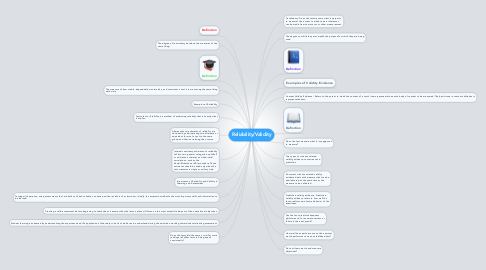Reliability/Validity
by Candace A. Stevens

1. Truthfulness: Does the test measure what it purports to measure? the extent to which certain inferences can be made from test scores or other measurement.
2. The degree to which they accomplish the purpose for which they are being used
3. Definition
4. Examples of Validity Evidence
5. Content Validity Evidence - Refers to the extent to which the content of a test's items represents the entire body of content to be measured. The basic issue in content validation is representativeness.
6. Definition
7. Definition
8. The degree of consistency between two measures of the same thing.
9. Definition
10. The measure of how stable, dependable, trustworthy, and consistent a test is in measuring the same thing each time .
11. Examples of Reliability
12. Test-retest or Stability-is a method of estimating reliablity that is exactly what it implies.
13. Alternate-form estimates of reliablity are obtained by administering two alternate or equivalent forms of a test to the same group and their correlating their scores.
14. Internal consitency estimates of reliability fall into two general categories: split-half or odd-even estimates and item-total correlations, such as the Kuder-Richardson (KR) procedure. These estimates should be used only when the test measures a single or unitary trait.
15. Importance of Reliablity and Validity in Learning and Assessment
16. Testing with purpose, using assessments that are both valid and reliable, can have positive results in the classroom. Ideally, the assessment reflects the most important skills and information to be learned.
17. Creating a valid assessment before beginning to teach the unit ensures that the lesson plans will focus on the most essential elements of the educational objectives.
18. Student learning is enhanced by understanding the importance and life application of the subject, both of which can be underlined during the unit when working toward the culminating assessment.
19. Does the test measure what it is suppposed to measure?
20. Two types of criterion-related validity evidence: concurrent and predictive
21. Concurent criterion-related validity evidence deals with measures that can be administered at the same time as the measure to be validated.
22. Predictive validity evidence- Predictive validity evidence refers to how well the test predicts some future behavior of the examinees.
23. Does the test yield the same or similar score rankings (all other factors being equal) consistently?
24. Can the test predict subsequent performance, for example success or failure in the next grade?
25. How well does performance on the new test match performance on an established test?
26. Do test items match and measure objectives?


